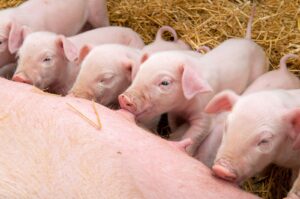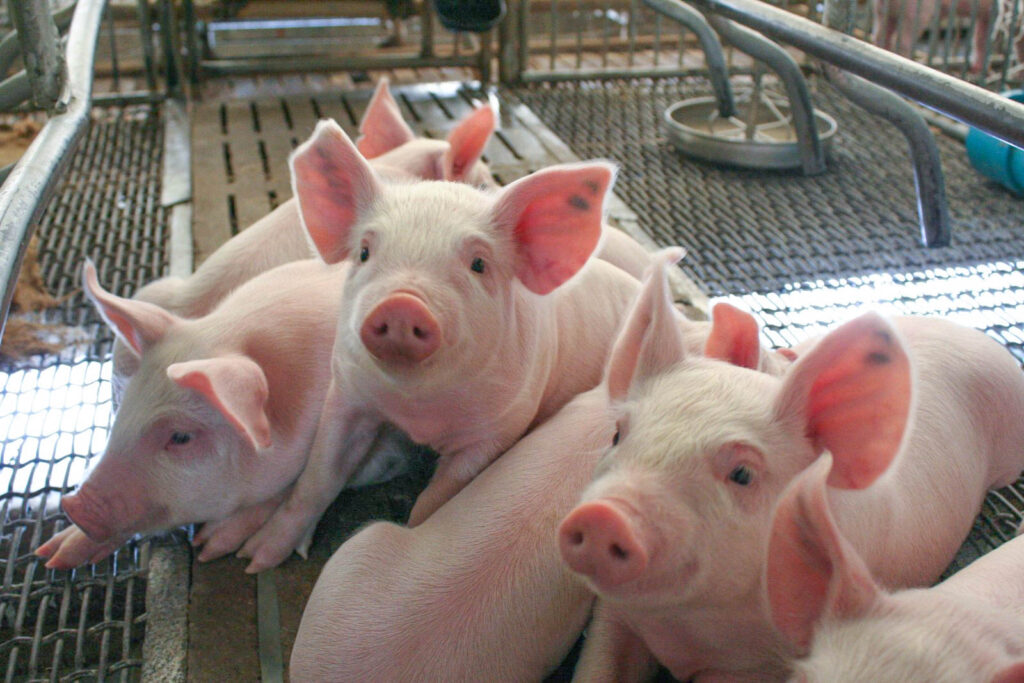Challenges and opportunities in optimising weaned pig health and performance
11th May 2023
On the back of zinc supplies running out and responsible antibiotic use becoming ever more important, getting weaned pigs off to a solid start is vital to protecting their welfare and safeguarding farm productivity. At a webinar hosted by the George Pig Practice and supported by Elanco, three experts discussed the challenges and practical solutions when it comes to weaned pig management.
Opening the session, Dr Richard B Pearson, MRCVS, director of the George Veterinary Group, outlined three central issues currently affecting the UK pig sector. These relate to zinc supplies running out later this year, concerns surrounding pig health and welfare, and the ongoing challenge of responsible antibiotic use.
While the pig sector has made considerable progress in reducing reliance on antibiotics, there is still a sizable amount of active antibiotics being used in UK pigs each year. Whereas, zinc oxide usage has varied from year to year, and has been in the region of 400 tons per annum, Dr Pearson pointed out (dataset up-to-date through 2019).
He remarked a detailed understanding of the journey pigs make during the weaning process is critical to building resilience in the sector going forward. He went on to describe the challenges faced by piglets at weaning as “numerous and diverse”, which can be divided into dietary, health, social and environmental challenges.
Dietary changes at weaning include an abrupt transition from milk to a solid feed diet, which can be alleviated by employing strategies such as transition feeders. Pigs also have to get used to different forms of feed and water provision post-weaning, often involving an unfamiliar feeder and drinker shape, size and design.
This can lead to post-weaning anorexia, which refers to otherwise normal pigs refusing to feed due to the various stressors, thus increasing the risk of health effects like impaired gut barrier function, nutrient malabsorption, diarrhoea with secondary dehydration, gut inflammation, and even systemic disease.
Meanwhile, environmental changes for weaned piglets include a different pen layout and ‘furniture’ – feeders, drinkers, sanitary facilities, shelter – as well as alternative floor surface, bedding and thermal conditions.
Whereas, social changes concern movement from the farrowing house to the new accommodation, often involving transport, and group size changes which can lead to conflict as the pigs will need to re-establish the pecking order, Dr Pearson added.
Lastly, the primary health challenges at weaning, often caused by one or more of the above stressors, include:
- Disease transmission – vertical and horizontal
- Faeco-oral transmission
- Hygiene and environmental contamination
- Concurrent disease
- Infections due to age segregation
- Waning MDA (maternally derived antibody) immunity
- Post-weaning diarrhoea (PWD)
- Oedema disease
According to Dr Pearson, the pathogens causing PWD are often ubiquitous, and how they affect the pig depends on various factors, which presents rearers with the opportunity to intervene. The main causative agents of the disease in the UK are Trichuris, salmonella, rotavirus and the F4/F18 strains of e. coli.
As with any disease, achieving a diagnosis is critical when dealing with PWD, as it enables vets to get the treatment right, prevention right, and understand why the disease has occurred in the first place, Dr Pearson explained.
Meanwhile, oedema disease is another manifestation of the bacteria e. coli in weaned pigs, caused by specific strains capable of producing shiga toxin. It is a very dramatic disease, characterised by high mortality, sudden deaths, and meningitis-like symptoms.
So far, zinc has been very effective in treating both PWD and oedema disease, and concerns have been raised industry-wide regarding supplies running out and the potential effects on weaned pig health and performance.
While vaccinal options are also effective, Dr Pearson noted this can be a ‘double-edged sword’ when administered to pigs with suboptimal immunity.
“Taking the stress out of weaning is about being ahead of the game”
Continuing along the lines of weaned pig health and welfare, Dr Alex Thomsett, MRCVS, pig veterinary specialist at the George Pig Practice, offered practical advice for achieving the best outcome post-weaning.
Dr Thomsett said the key factors influencing the weaning process are management, nutrition, immune status and the interaction of these. To minimise stress relating to management, farmers must optimise husbandry, hygiene, resource uptake and environmental conditions, all of which need to work together to achieve the best results.

Maximising colostrum intake in the first 24 hours of life is crucial to protecting young pigs from infections and disease.
Pre-weaning prep is key when it comes to getting the best out of weaned pigs, she continued, as pigs that are compromised beforehand will never reach their full potential. Colostrum intake is of vital importance, and various strategies exist for maximising intake, such as:
- Split suckling
- Assisted suckling
- Cross fostering
- Optimising udder access
Promoting good gut health pre-weaning is also essential and can be achieved via milk supplementation and creep feeding. This will help develop the pig’s gut microbiota and innate immunity, promoting a robust animal that is able to deal with stressors.
Again, preparation is key in making sure the weaned pig is as best accommodated as possible, Dr Thomsett said. This involves making sure the accommodation is cleaned, disinfected and dry, and is brought up to optimal temperature before the pigs arrive.
Farmers must also make sure pigs have access to sufficient clean, dry bedding, plenty of spaces to hide and ample space around feeders and drinkers to avoid conflicts. Actively encouraging the pigs to these facilities can also help them settle in, she added.
Ventilation is another key area to get right, as pigs will focus on staying warm by default and stop eating if too cold, which can precipitate enteric problems relatively quickly.
The journey the animals take at weaning must also be carefully considered, Dr Thomsett said, as both long and short-distance travel poses risks. If transporting pigs in a lorry or trailer, these must be thoroughly cleaned and disinfected to avoid cross-contamination, and potential issues such as dehydration, transport fatigue, and disagreements within groups should be taken into account.
Whereas, if the pigs are walked to the new accommodation, the route must also be clean and free of contaminants. Dr Thomsett encouraged farmers to think about the risks involved in moving pigs and possible ways to improve the process.
With regards to disease resistance, she advised exploring feed ingredients such as probiotics and prebiotics to support the pig’s immune status and gut microbiota. Like Dr Pearson, she also raised concerns against vaccinating weaned pigs and suggested farmers choose an alternative timing, identify pathogens they’re vaccinating against, and review handling options to minimise stress.
Lastly, she urged the audience to listen to the pigs and spend a bit of time observing their behaviour. Lying habits, noise levels, vices and dunging patterns can all indicate whether there’re any changes that need to be made in order to maximise the environment for weaned pigs.
Dietary and vaccinal strategies at weaning
In the final talk of the webinar, Dr Agustina Rodrigues, MRCVS, technical nutritionist consultant at Elanco, provided recommendations for nutritional and vaccination management of weaned pigs.
Throughout her presentation, Dr Rodrigues emphasised the importance of achieving optimum balance of essential nutrients in pig diets. Beginning with crude protein, a macromolecule composed of a sequence of essential and/or non-essential amino acids, she delved into optimising the protein content of feed formulations to benefit growth and weight gain.
As essential amino acids cannot be synthesised by the pig itself, these must be supplied in the diet along with sufficient amino nitrogen to allow for the synthesis of non-essential amino acids.
Dr Rodrigues explained the balance of these ingredients is determined by the age of the pig, the challenges the animal is facing, and whether there is a need to mount an immune response, amongst other factors.
She also reminded the audience about the main limiting amino acids (lysine, methionine, and tryptophan), which must be supplied in sufficient amounts for the pig to get the most out of the diet.
For young pigs with an immature gastrointestinal system, she recommended a low protein diet to reduce the growth of proteolytic bacteria and pathogenic e. coli and mitigate PWD symptoms and intestinal inflammation. However, she warned that an incorrectly balanced diet could decrease pig performance, especially in non-supplemented animals.
Moving on to fibre, which is composed of non-starch polysaccharides and lignin, Dr Rodrigues established once again that balance is critical. Both soluble and insoluble fibre promote intestinal integrity and healthy microbiome in pigs by respectively increasing short chain fatty acids and accelerating the passage rate of feed in the gut.
Regarding feed additives, she highlighted organic acids, phytogenics, probiotics and prebiotics as ingredients that promote antimicrobial activity, intestinal integrity, nutrient digestibility, and gastric acidity, with each offering unique benefits that help increase resilience to stress.
An area of particular focus in her presentation were enzymes, which are substrate-specific biological catalysts that are almost always made up of proteins. Explaining the potential of enzyme supplementation in pigs, she said:
“The more substrate we have, the more efficient the enzyme is, and the younger the animal is, the greater the effect, as their enzyme activity is quite low – even small supplementation will have a huge effect.”
According to Dr Rodrigues, the main enzymes to consider in pigs are phytase, xylanase, beta-glucanase, beta-mannanase, and protease, with shared benefits including improved intestinal integrity, nutrient digestibility, diet optimisation, and decreased inflammation.
“They’re going to allow the nutritionist to be more flexible with diet formulations and the diets to be more cost-effective as we’re making more out of them,” she added.
Wrapping up with a note on PWD vaccination, Dr Rodrigues said Coliprotec is available as an oral F4/F18 enterotoxigenic e. coli vaccine and can be administered from 18 days of life. Key benefits include increased gut health and performance and decreased antibiotic usage and mortality in pigs exposed to e. coli.
Finally, she advised farmers to make sure the F4/F18 strains are identified on the farm in order for the vaccine to be effective.

